Standing in the centre of the Piazza del Duomo is one of the most famous structures in Florence, the Baptistery of St. John. The bright white marble exteriors, trimmed in green and pink stone, are unique and iconically Florentine. It would live right here if there were a beating heart to this city.
Whether you’re drawn to the grandeur, the history or the spiritual power of these buildings, visiting these sites in Florence is almost a right of passage. But many people come here and gaze upon these buildings without understanding the context behind their construction and artistry. Through this post, I hope to help illuminate some of those mysteries and perhaps help you appreciate these attractions for more than just their beauty.
Baptistery of San Giovanni Battista
The Baptistery of San Giovanni Battista is thought to be one of Florence’s oldest places of worship. The current Baptistery was built between 1059 and 1128. It was named after St. John the Baptist (San Giovanni Battista), the patron saint of Florence. As Christianity was attempting to overtake the Pagan religion, Christians needed to find ways to make this conversation as seamless as possible.
One of these ways was to replace one Roman god for a Christian saint. That’s how we have St. John the Baptist as the patron saint of Florence. He replaced their most worshiped god, Mars. Mars was the god of war, so they needed to find a saint with a similar appeal. Saint John was a rugged saint, not as seemingly “holy” or clean-cut as some others, and this seemed to gel with Florentine sensibilities.
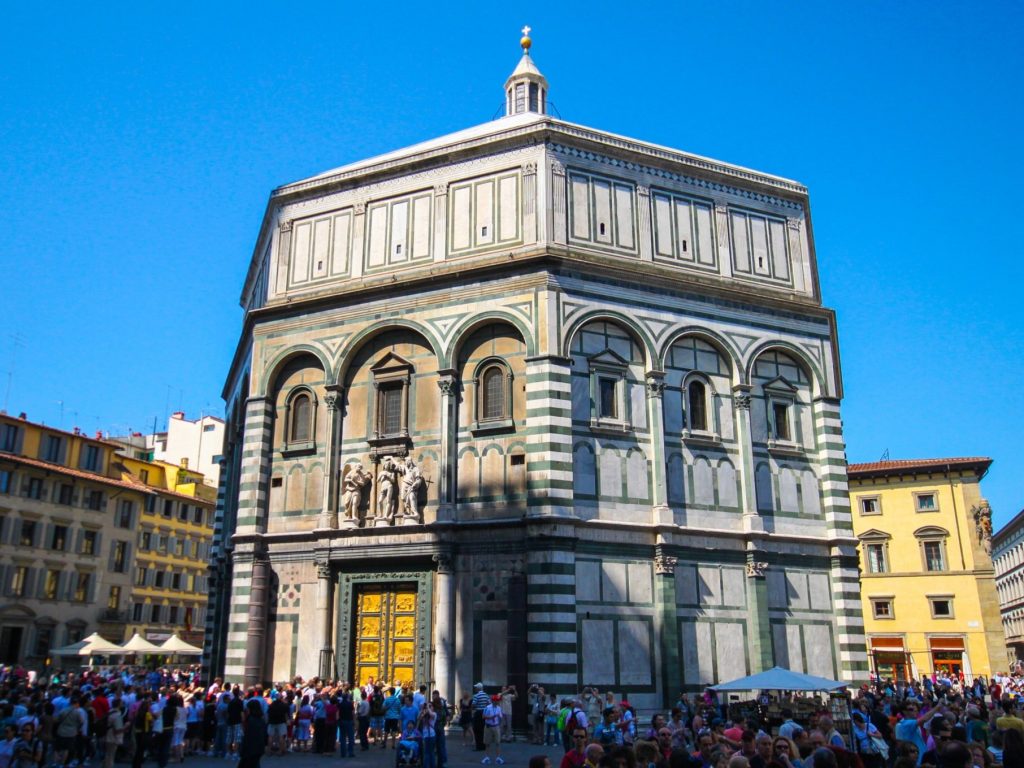
Florence Artists
The octagonal floor plan for the Baptistery was ubiquitous during the first millennium of Christianity, although it is much more rare to find these days. The octagonal design has a beautiful sense of symmetry to it, creating this unified, peaceful design. There is no clear provenance of who designed the structure, but many famous names have been attributed to its design. Pisano, Giotto, Ghiberti, Donatello and even Leonardo da Vinci were all artists who lent their hand in the creation of the Baptistery. Being a place touched by so many master’s hands only makes it more critical in the history of the city.

The Baptistery Portals
In addition to the marble we spoke of before which was used, bronze was the primary material which they employed to create a lush and regal look for the doorways. They called these entrances “portals,” and they were the gateways into the palace of god.
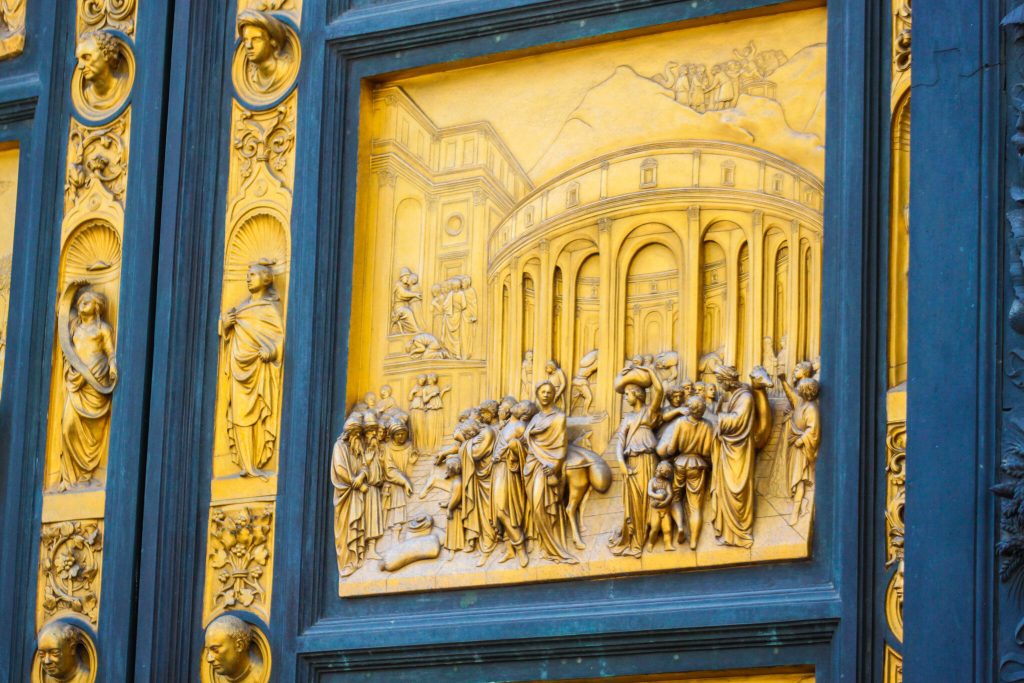
Pisano’s Southern Portal
The oldest set of doors is that created by Andrea Pisano in 1329. These doors now face south, but initially faced east, towards the Duomo. They were moved in 1452, replaced by newer designs. These doors depict stories from the Old Testament. The Merchants Guild of Florence commissioned Pisano to build these doors. They were one of the wealthiest guilds in the city and as such, could afford such an expensive commission. Look closely at the carvings and notice that there is definitely a significant amount of detail paid to the clothing.

No doubt, this was a way for the guild to get a subtle nod to their trade’s manufacturing in there. Subtle advertising if you will. The overall look of these designs is more subdued than the newer doors. Their shapes of the people are less realistic, and the features in their faces don’t show any real emotion. My favourite part of the design is the richly decorated door frames. They are lush with greenery and flowers. They seem to almost be bursting with growth.
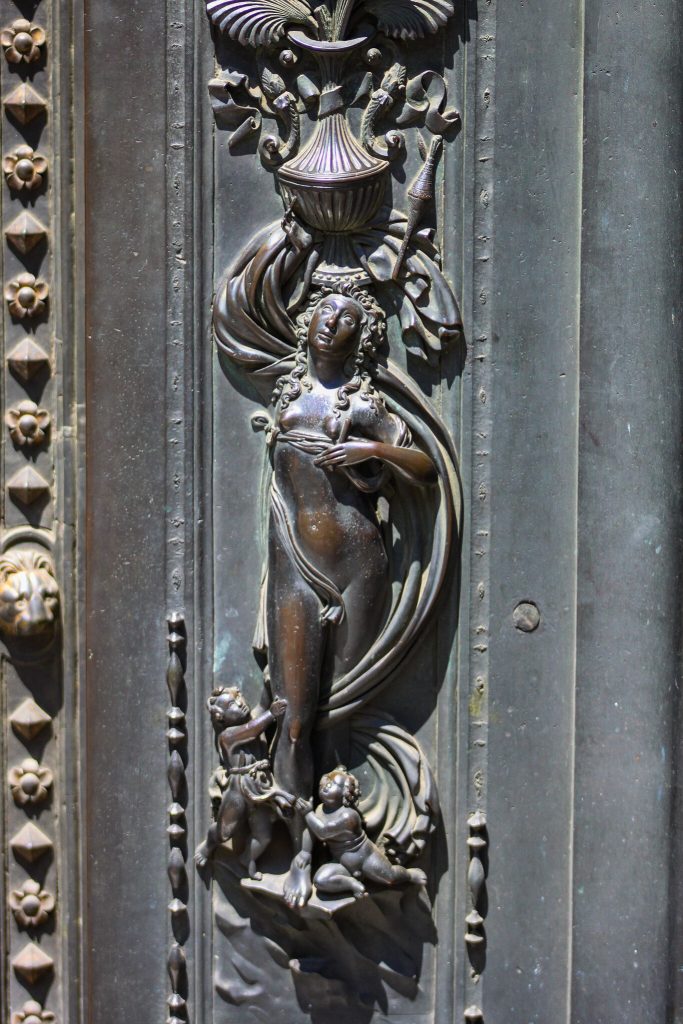

Ghiberti’s Northern Portal
The second set of doors, located on the northern side, was designed by Lorenzo Ghiberti in 1422. But Ghiberti wasn’t just hired on the spot, oh no. In 1401 the church held a competition to see who would win the honour of receiving this commission. The church wanted to celebrate the end of the Black Death, which had swept through much of Europe, leaving millions dead. Florence had miraculously been spared, with only a comparatively small fraction of their citizens who ended up dying from the disease. Artists had to submit a small bronze panel featuring the scene of Abraham Sacrificing Isaac to be entered into the competition.
In the end, the committee was stuck between Brunelleschi’s design and Ghiberti’s. They couldn’t choose and asked if the artists would be willing to work together. Brunelleschi refused, saying that anything less than something which was 100% his own work wasn’t worth his time. So the job went to Ghiberti. It took Ghiberti 21 years to complete these doors. The panels in these doors consist of 28 scenes of the life of Jesus Christ from the New Testament. Each of them is richly decorated. The scenes are framed by abundant foliage and gilded busts of prophets and sibyls (women able to foretell the future). These doors are copies of the originals as those ones are now housed at the Cathedral Museum. But the recreations are nonetheless incredible examples of this sculptural art form, which was emerging at the time.

Ghiberti’s Eastern Portal
The third set of doors, created in 1425-1452, was also created by Ghiberti after his first commission was such a success. Michelangelo called them “the gates of paradise,” and therein came the name they go by even today. Michelangelo would often come here as a student to study these works for art. These panels are much larger than the quarterfoil frames of the previous gates. There are only ten frames in total, depicting scenes from the Old Testament and the life of Saint John the Baptist.
Ghiberti Artistry
In this new series, Ghiberti used a technique called schiacciato. This technique allowed him to create a recessed sculpture by carving only millimetres deep. It gives the illusion of greater depth and movement in the scene. The previous panels were mostly focused on the people in the scene and not the environment. In these new renditions, Ghiberti added in the landscape, which brought so much more atmosphere to each panel. Framing the doors are a series of miniatures busts and sculptures. The two busts featured in the middle of the entries are actually a self-portrait of the artist and his father, Bartolomeo Ghiberti.
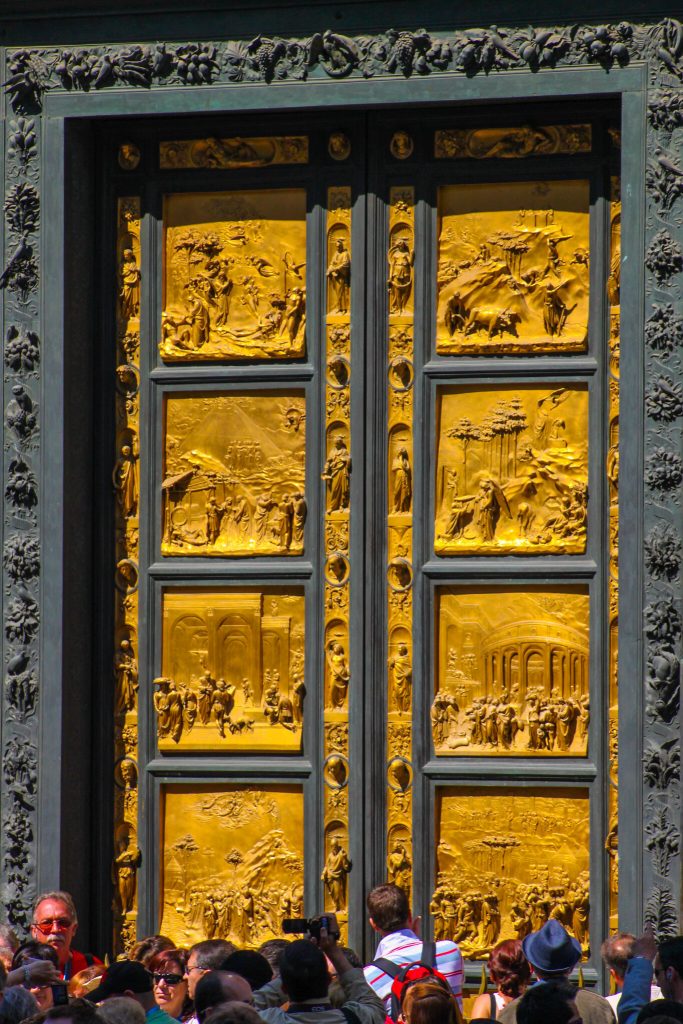
Above the doors are three marble statues on white pedestals. In the centre, we have Jesus being crowned by John the Baptist, being watched by an angel.
Baptistery Interior
The interior of the small Baptistery is wonderfully embellished, and it feels like no matter where you look, there is something magical to behold. This is in complete opposition to the rather austere interior of the Cathedral across the street.
Domed Mosaics
The interior was inspired by the Roman Pantheon with its grand domed ceiling covered in intricate byzantine mosaics. The roof was created in the 1200s. Millions of tiny gold and glass tiles were used to create the scene of “universal judgement.” The entire piece took over 100 years to complete. Because the section took so long to complete, you can actually see the change in art styles throughout the design as the techniques improved and changed throughout the years. Descending down from the centre of the octagonal dome, there are various rings, which depict specific storylines around the central theme of judgement.
Life of Joseph, the Virgin Mary and Jesus and St. John the Baptist
The top layer of the octagon, under the lantern, is decorated with plants and animals. Below this is a series of angels who surround and stand in praise towards the image of Jesus is the centre. Below is a set of scenes from the story of Genesis. Following this are images from the Life of Joseph, the Virgin Mary and Jesus and finally the life of St. John the Baptist, the patron saint of Florence.
In the center, breaking into multiple rows is the central figure of Jesus. He sits with this hands to either side, the marks of the crucifixion nails still bleeding in the centre of his palms. To the right of his feet are images of damnation and to the left, salvation. The images of damnation are explicitly terrifying, as the representations of the tortures of hell are extremely brutal. The shapes of the various figures here aren’t human figures and look almost alien-like as if hell itself mutates the human form. These terrors were meant to strike fear into the citizens of Florence, to be good in life to not suffer in the afterlife for eternity.
The Marble Floor
After looking up for long so, give your neck a break and take a look at the ground. The marble floor here is made using the technique called ‘intarso.’ This technique uses multiple colours of marble, which are carefully placed together to create one unified piece. At one time, the lantern in the ceiling was open to the outside air, and the light which flowed in would hit a sundial embedded into this marble floor. Florentine designers used astrological signs, along with the sundial, to tell the time. Although the lantern was closed and the dial removed, the zodiac signs on the marble can still be seen on the floor today.
The Tomb of Guccio de Medici
The tomb of Guccio de Medici, who died in the 1300s, is the first example of the Medicis obsession with their deaths being as opulent as their lives. When he died, Guccio was buried inside an old Roman sarcophagus. Added onto the Roman tomb was a carving of the Medici shield and famous Medici coins.
The Tomb of the Anti Pope
One of the most controversial tombs in the Baptistery is the tomb of Antipope John XXIII. Pope John XXIII was born Baldassari Cossa. Despite being buried in such an illustrious building, this Pope was stripped of his title after his death due to his multiple misdoings and scandalous life. He was widely disliked by almost everyone in Florence, everyone except that is for the Medici’s that is. When Cossa came into power, he gave the financing of the Vatican over to the Medici bank. The Vatican was one of the largest institutions in the world and employing the Medici bank as their primary money lender meant the families rise to fame. They went from being just another Florentine money lender to one of the richest (non-royal) families in Europe.
Donatello and the Baptistry
The Medici’s owed Cossa, and despite the public’s dislike or outright hate for the man, they were still under his thumb. When his dying wish was to be buried in the Baptistery, they made his dream come true, despite the public outrage that ensued. The Medici’s paid Donatello to sculpt his funerary monument in 1420. On top of the tomb is his death mask. Unlike many death masks of the time, Cossa’s faces look out towards the onlooker instead of up towards the sky. Almost daring the public to say a word against him, as he is always looking and listening. Above his coffin is a lunette of the Madonna and child. The entire piece is a stone canopy is embellished with golden fringe. Supporting the coffin on either side are two Marzocco Lions, the protectors of Florence.
There is so much more to see around the Baptistery, so once you’re finished here, be sure to head over to tour the famous Duomo! If you’ve visited the Baptistery in Florence, let me know in the comment what your favourite part was!
Happy Travels Adventurers.
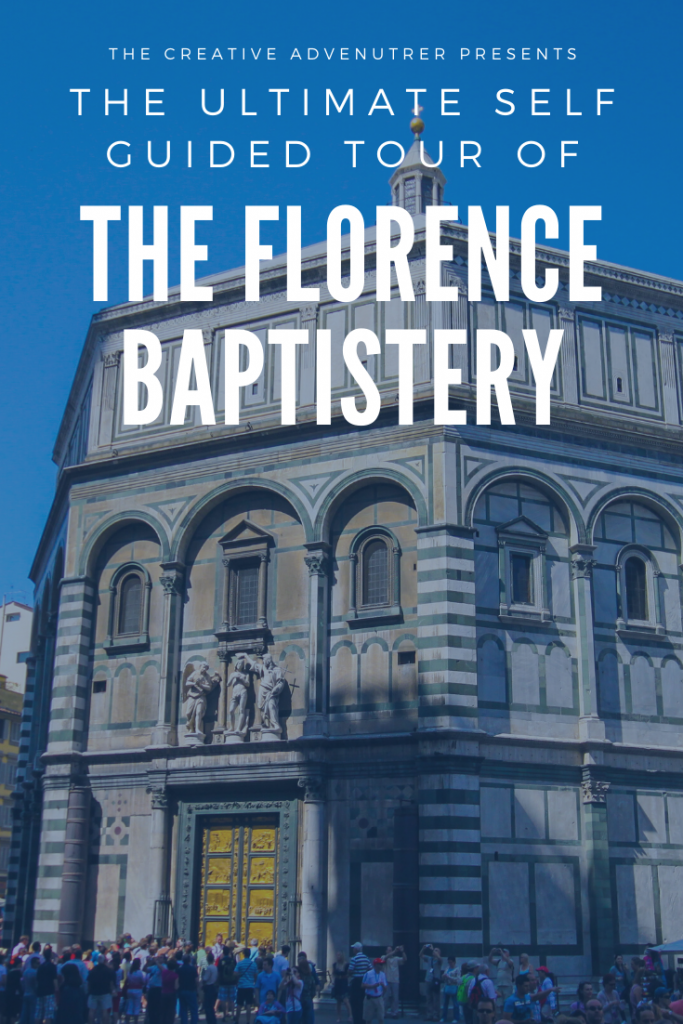
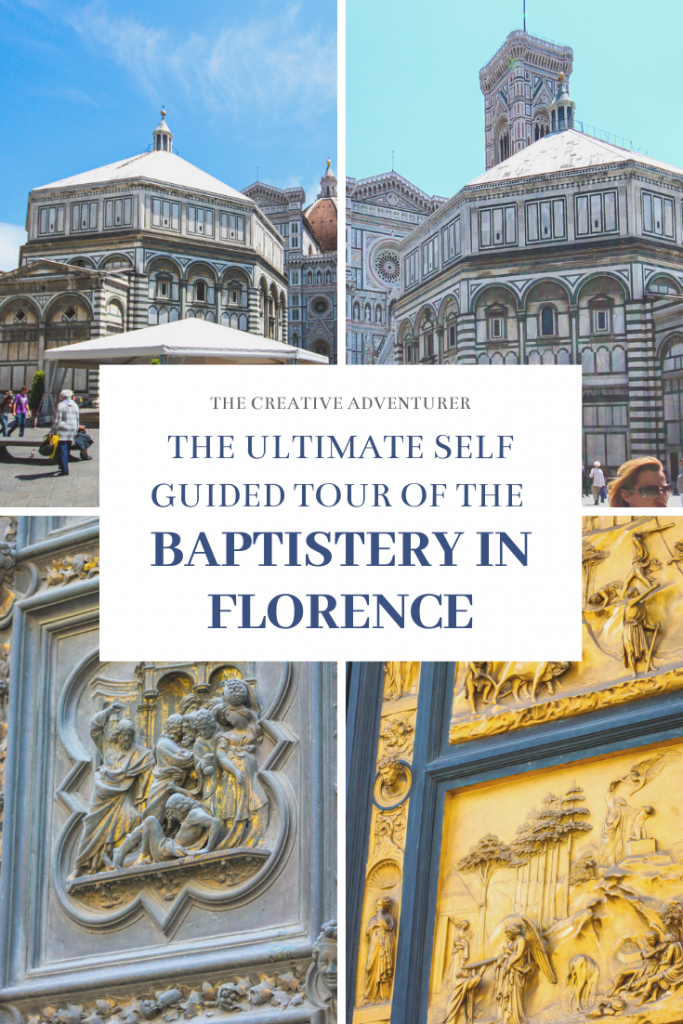
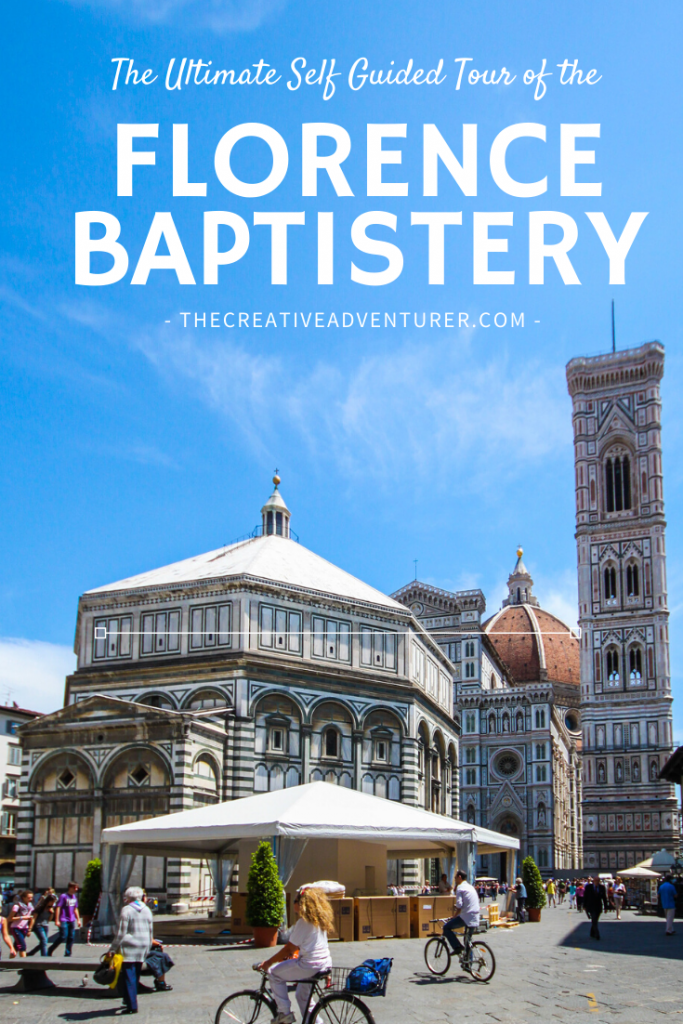


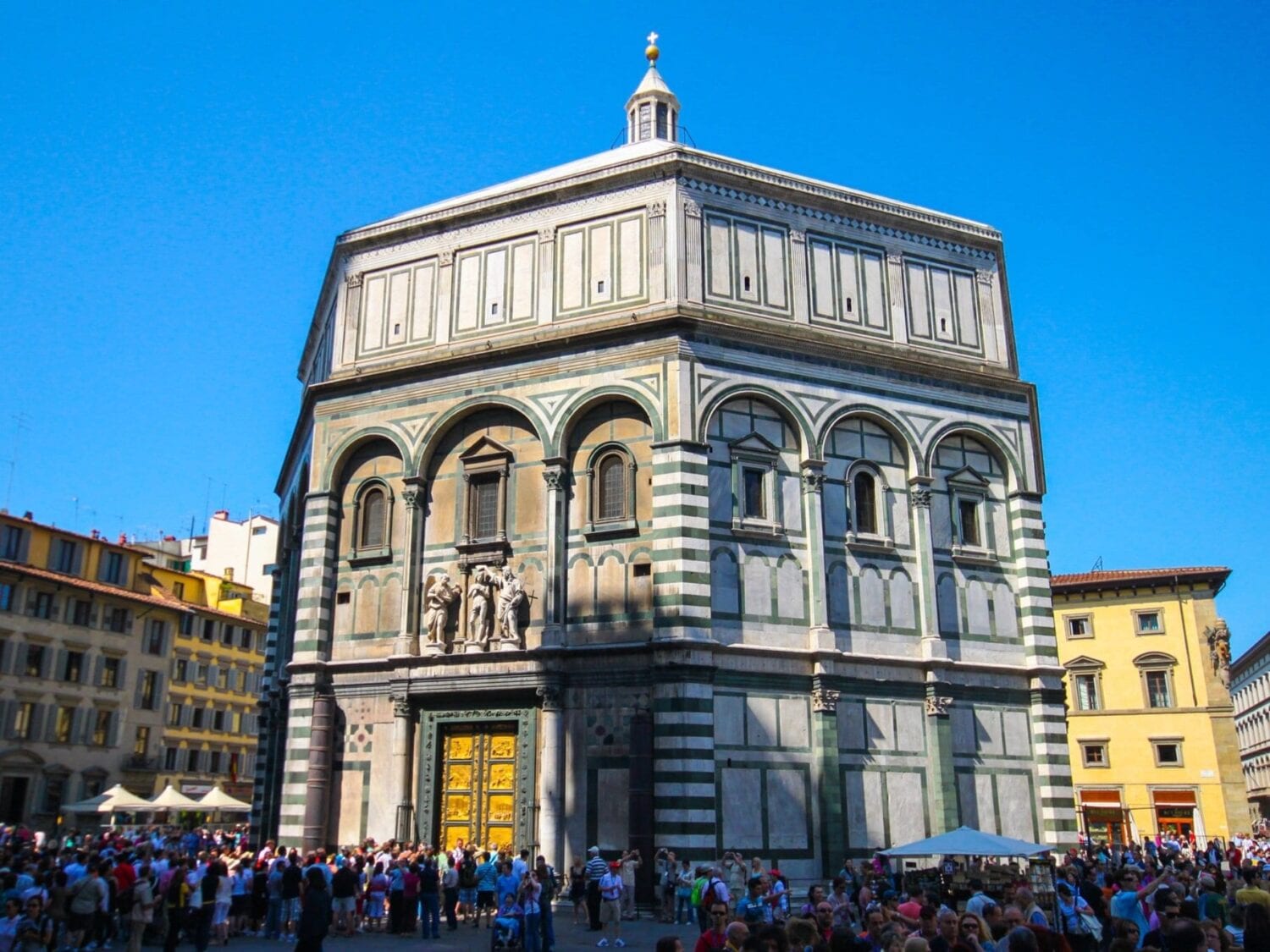
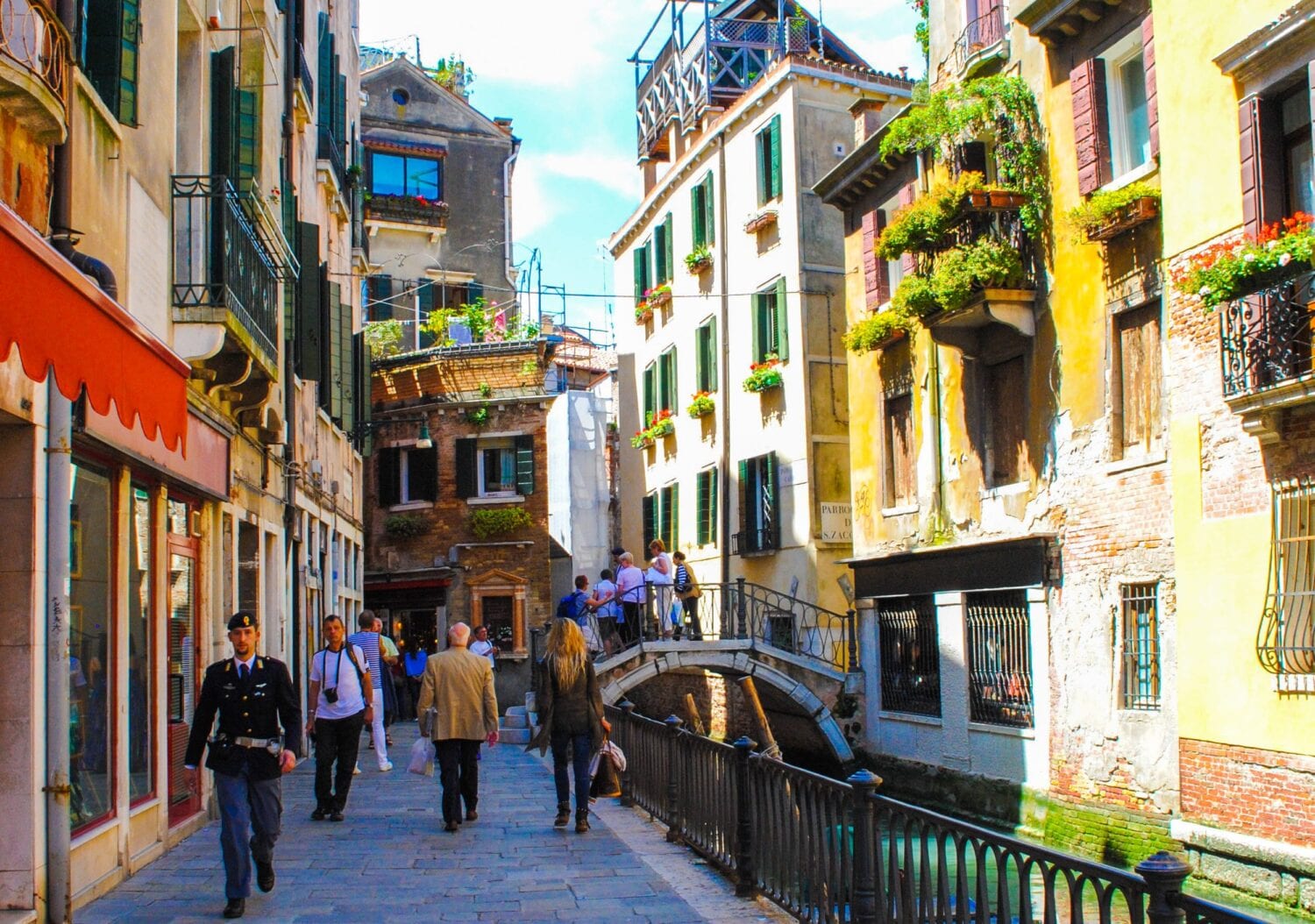
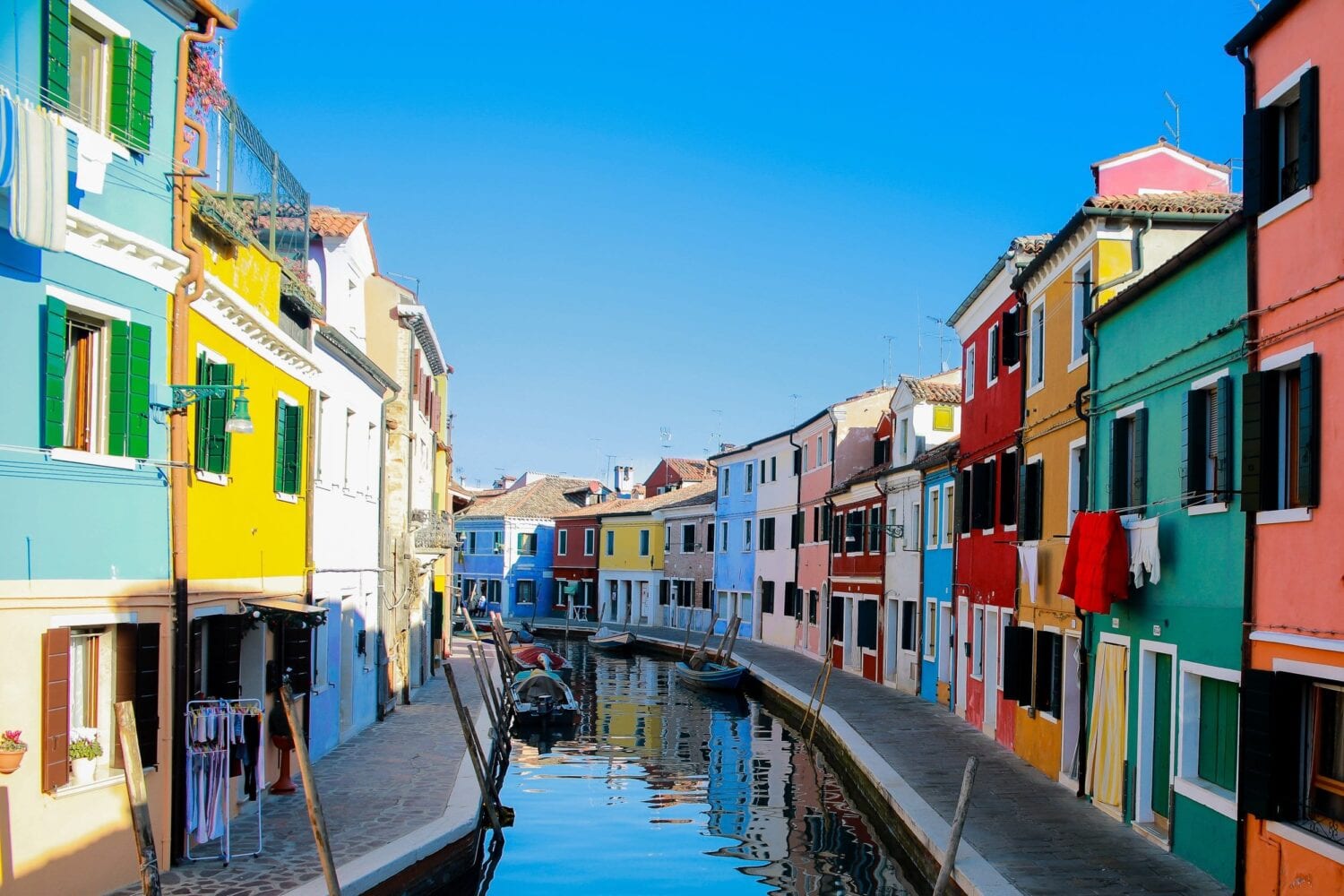
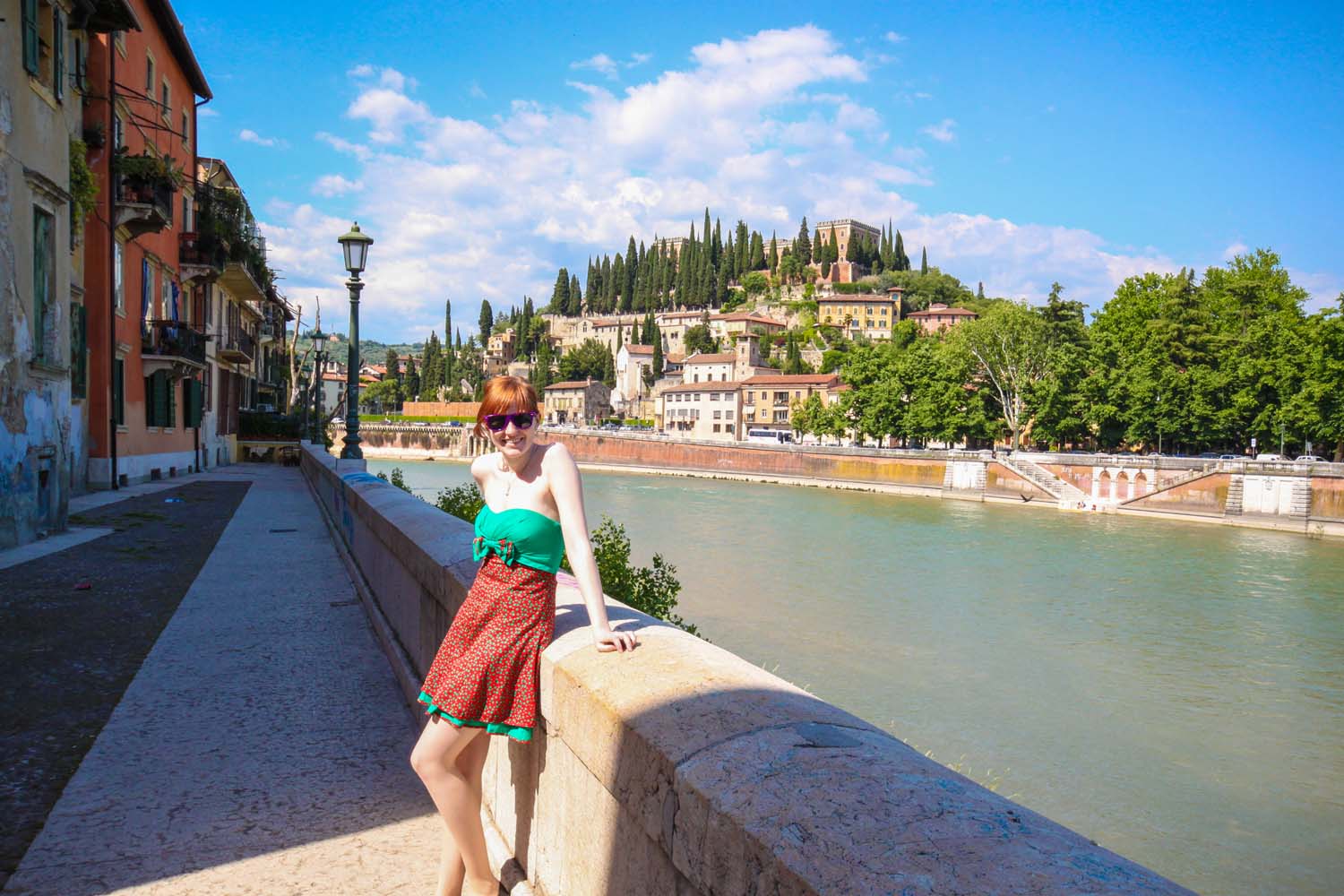

Leave a Comment